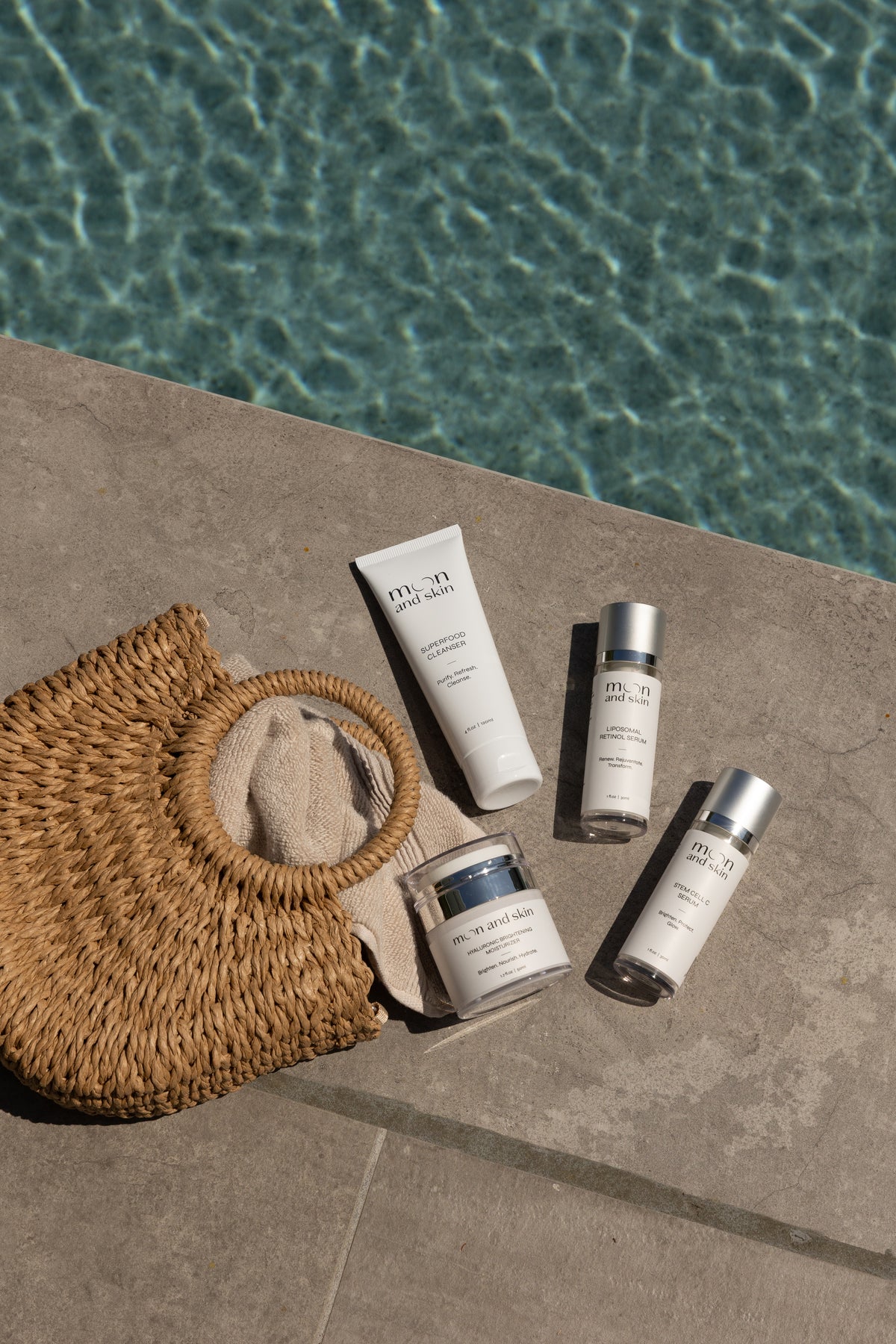Table of Contents
Introduction
Did you know that consistent skincare can lead to healthier, more radiant skin over time? Many of us grapple with skin issues, from dryness to acne, and often wonder about the most effective way to care for our skin. As a brand dedicated to clean and thoughtful skincare, we at Moon and Skin understand that navigating the world of skincare can feel overwhelming. However, establishing an effective skincare routine is essential for maintaining and enhancing your skin's health, no matter your age or skin type.
In this post, we aim to guide you through the essential steps of creating a personalized skincare routine that suits your unique needs. We will explore each step in detail, highlighting the benefits of our carefully formulated products along the way. Together, we'll break down the process to help you achieve your skincare goals, emphasizing the importance of education and self-care in your skincare journey.
Thesis Statement
By the end of this article, you will have a clear understanding of how to establish a skincare routine tailored to your skin type and concerns, utilizing our signature products designed to nourish and protect your skin through every phase of life.
Understanding Your Skin Type
Before diving into the steps of a skincare routine, it's crucial to identify your skin type. The most common skin types include:
- Normal Skin: Balanced moisture levels, few imperfections, and minimal sensitivity.
- Dry Skin: Lacks moisture and can feel tight or rough; often accompanied by flakiness.
- Oily Skin: Characterized by excess oil, enlarged pores, and a tendency for breakouts.
- Combination Skin: A mix of dry and oily areas, typically oily in the T-zone (forehead, nose, and chin) and dry elsewhere.
- Sensitive Skin: Prone to redness, irritation, and reactions to products or environmental factors.
Identifying your skin type will help you choose products that cater to your needs effectively. Let's now explore the steps to build a skincare routine that harmonizes with your unique skin requirements.
Step 1: Cleansing
Cleansing is the cornerstone of any skincare routine. It helps remove dirt, oil, and impurities accumulated throughout the day, ensuring your skin is primed for the following steps.
Why Cleansing is Important
Cleansing not only helps maintain a clear complexion but also prepares your skin to absorb the beneficial ingredients in other products. Think of cleansing as clearing the stage for a performance; without a clean surface, your skincare products cannot shine.
Choosing the Right Cleanser
At Moon and Skin, we offer the Superfood Cleanser, which utilizes HydroProtein Technology to nourish and cleanse your skin gently while removing impurities. This cleanser is perfect for all skin types, providing a refreshing start to your routine.
How to Cleanse:
- Use lukewarm water to dampen your face.
- Apply a small amount of cleanser and massage gently in circular motions.
- Rinse thoroughly and pat dry with a clean towel.
Key Takeaway
Cleansing is essential for maintaining a healthy complexion. Choose a cleanser that respects your skin's natural barrier and prepares it for further treatment.
Step 2: Toning
Toning acts as a bridge between cleansing and moisturizing, helping to restore the skin's pH balance and providing an extra layer of hydration.
The Role of Toner
Modern toners are not the harsh astringents of the past. They are now formulated with nourishing ingredients that hydrate and prepare the skin for serums and moisturizers.
How to Use Toner:
- After cleansing, apply toner on a cotton pad or use your hands to gently pat it onto your skin.
- Focus on areas that may need extra hydration or care.
Choosing the Right Toner
While we don’t have a specific toner in our product range yet, consider incorporating one that complements your skin type. Look for toners with hydrating ingredients, such as rose water or aloe vera, that calm and soothe the skin.
Key Takeaway
Toning is a vital step that replenishes the skin and enhances the effectiveness of subsequent products.
Step 3: Exfoliation
Exfoliation is the process of removing dead skin cells to promote a smoother and brighter complexion. However, it’s essential to strike a balance; over-exfoliating can lead to irritation.
Benefits of Exfoliation
Regular exfoliation encourages cell turnover, helping to prevent clogged pores and dull skin. Depending on your skin type, you may choose between physical exfoliants (scrubs) and chemical exfoliants (acids).
How to Exfoliate:
- Use an exfoliant 1-2 times a week, depending on your skin's tolerance.
- Apply a small amount to damp skin and gently massage in circular motions.
- Rinse thoroughly and follow up with a toner.
Choosing the Right Exfoliant
Our Liposomal Retinol Serum can serve as an excellent option for gentle exfoliation, promoting skin renewal without irritation. It features Centersome®RL technology for maximum results with minimal discomfort.
Key Takeaway
Exfoliation is key to maintaining a radiant complexion, but moderation is crucial. Choose the right type for your skin and avoid overdoing it.
Step 4: Treatment
After cleansing and exfoliating, it’s time to address specific skin concerns with targeted treatments such as serums or concentrates.
The Importance of Treatment
Serums are concentrated formulations that deliver active ingredients deep into the skin. They can target various issues, from hydration to pigmentation and aging.
How to Apply Serum:
- Apply a few drops of your chosen serum onto your fingertips.
- Gently press and massage into your skin, focusing on areas of concern.
Choosing the Right Treatment
We recommend our Stem Cell C Serum for its brightening and hydrating properties. It utilizes advanced plant-cell technology and stable, acne-safe vitamin C, making it suitable for all skin types.
Key Takeaway
Incorporating a treatment step into your routine allows you to target specific issues effectively, enhancing your overall skin health.
Step 5: Moisturizing
Moisturizing is crucial for all skin types, even oily skin. It helps maintain hydration and strengthens the skin's barrier against environmental stressors.
Benefits of Moisturizing
A good moisturizer helps to lock in hydration and provide essential nutrients to the skin. It also creates a protective layer that prevents moisture loss.
How to Moisturize:
- Apply a dime-sized amount of moisturizer to your face and neck.
- Use upward strokes to ensure even coverage.
Choosing the Right Moisturizer
Our Hyaluronic Brightening Moisturizer is an excellent choice, featuring hyaluronic and kojic acid to deeply hydrate and brighten your skin. This moisturizer is designed for acne-prone skin, ensuring that you can hydrate without worrying about breakouts.
Key Takeaway
Moisturizing is essential for maintaining skin hydration and protecting against environmental factors. Choose a formula that complements your skin type and concerns.
Step 6: Eye Care
The skin around the eyes is delicate and often requires special attention to address concerns like puffiness, dark circles, and fine lines.
The Importance of Eye Cream
Eye creams are specifically formulated to address the unique needs of the eye area, providing targeted hydration and treatment without irritation.
How to Apply Eye Cream:
- Use your ring finger to dab a small amount of eye cream around the orbital bone.
- Avoid applying too close to the lash line to prevent irritation.
Choosing the Right Eye Cream
While we currently don’t have a dedicated eye cream in our range, look for products that contain ingredients like caffeine, peptides, or hyaluronic acid to brighten and hydrate this sensitive area.
Key Takeaway
Investing in a good eye cream can make a significant difference in the appearance and health of the delicate skin around your eyes.
Step 7: Sun Protection
Sunscreen is the final step in your morning skincare routine and one of the most critical for preventing skin damage.
Why Sun Protection Matters
Regular use of sunscreen protects against harmful UV rays that contribute to premature aging, pigmentation, and skin cancer. It is essential to use a broad-spectrum sunscreen with at least SPF 30.
How to Apply Sunscreen:
- Apply sunscreen generously to all exposed areas of your skin, including the face, neck, and ears.
- Reapply every two hours, more frequently if swimming or sweating.
Choosing the Right Sunscreen
While we don’t currently offer a sunscreen, look for formulas that are lightweight and suitable for your skin type. Consider mineral-based options for sensitive skin.
Key Takeaway
Sun protection is crucial in maintaining healthy skin and preventing damage. Make it a non-negotiable part of your daily routine.
Step 8: Nighttime Routine
Your nighttime routine should focus on repair and recovery. This is when your skin can benefit from richer products to nourish and rejuvenate.
The Importance of Nighttime Care
At night, your skin undergoes a natural repair process, and a proper nighttime routine can enhance this process. Here’s how to adjust your morning routine for nighttime:
- Cleanse: Use the same cleansing method to remove makeup and impurities.
- Exfoliate: You may choose to exfoliate, but only a couple of times a week.
- Toner: Apply toner as you did in the morning.
- Treatment: This is a great time to apply more potent treatments, such as our Liposomal Retinol Serum, which works overnight to improve texture and tone without irritation.
- Moisturize: Use a richer moisturizer if your skin feels particularly dry.
Key Takeaway
Nighttime is when your skin can truly benefit from restorative products. Tailor your routine to enhance this natural process.
Conclusion
In establishing a skincare routine, we can empower ourselves to achieve healthier, more radiant skin. By understanding the importance of each step and choosing products that align with our skin's needs, we can foster a relationship with our skin that evolves over time.
At Moon and Skin, we encourage you to explore our Bundle & Save collection to build a complete skincare routine at a better value. Together, we can celebrate your skin through every phase of life, ensuring it gets the care it deserves.
FAQ
1. How often should I cleanse my face? You should cleanse your face twice a day—once in the morning and once at night—to remove impurities and prepare your skin for treatment.
2. Can I skip moisturizer if I have oily skin? No, moisturizing is essential for all skin types, including oily skin. Look for lightweight, oil-free moisturizers to hydrate without clogging pores.
3. How do I know if I should exfoliate? If your skin feels rough or looks dull, it may be time to exfoliate. Generally, exfoliating 1-2 times a week is effective for most skin types.
4. Is it necessary to use sunscreen even on cloudy days? Yes, UV rays can penetrate clouds and still harm your skin. Always apply sunscreen as part of your morning routine.
5. How long does it take to see results from a skincare routine? Results can vary, but most people should allow at least four to six weeks to see noticeable improvements in their skin.
By following these steps and incorporating our thoughtfully crafted products, we can navigate the journey of skincare together. Here’s to celebrating radiant, healthy skin!







